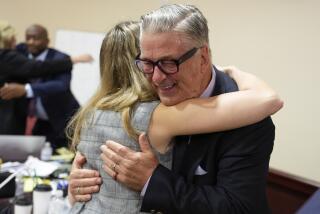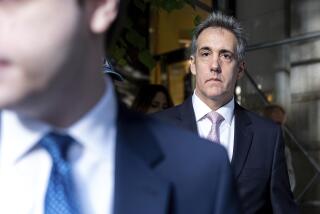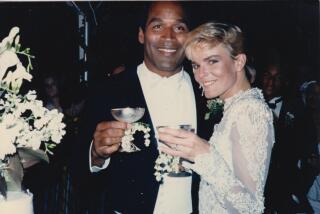Defense Begins Questioning of Coroner
After eight days of sometimes gruesome testimony about the autopsies of Nicole Brown Simpson and Ronald Lyle Goldman, one of O.J. Simpsonâs attorneys launched his cross-examination of the county coroner late Wednesday by belittling the significance of the doctorâs medical conclusions.
Robert L. Shapiro, the lawyer who built Simpsonâs legal team but has played a minimal role during the trial itself, politely but forcefully suggested that the coronerâs closely watched testimony--which has detailed every wound to the victims and has provided the jury with elaborate descriptions of how the killings might have been carried out--was far more speculation than substance.
âIsnât it true, doctor, after eight days of testimony, thereâs only four facts you can testify to with a reasonable degree of medical certainty?â Shapiro asked, referring to four basic conclusions of the coronerâs testimony: That the deaths were homicides, that the fatal injuries were stab wounds, that the victims bled to death and that they were killed between 9 p.m. and shortly after midnight.
Deputy Dist. Atty. Brian Kelberg objected to that question, but Superior Court Judge Lance A. Ito overruled the objection.
âIâve already discussed the findings,â Dr. Lakshmanan Sathyavagiswaran responded with a hint of defensiveness. âIâve discussed my opinion that there were significant stab wounds to both of the victims. I opined that the significant wounds on the bodies were caused by a single-edged knife. . . . I donât think my eight days of testimony have been wasted, but if thatâs your position, I canât change it.â
Shapiroâs cross-examination barely got under way before the end of the court day Wednesday, but he used his initial questions to attempt to undermine the impact of the coronerâs testimony. He did that first by suggesting that much of it was speculative and then by insinuating that Sathyavagiswaran was bending some of his findings to fit the prosecutionâs theory of the crimes, particularly the governmentâs contention that the two victims were killed about 10:15 p.m. on June 12, 1994, a time for which Simpson has no firm alibi.
In response to questions from Shapiro, the coroner acknowledged that he cannot be sure exactly what time the victims died, how many weapons were used in the attack or how many assailants were responsible.
âYou cannot say with a reasonable medical certainty how many people were responsible?â Shapiro asked.
âNo,â the coroner answered.
At least six of the jurors were rapidly scribbling notes during that portion of the testimony. Simpson, who has pleaded not guilty, also followed attentively, a sharp contrast to his apparent distraction earlier in the day as the prosecution completed its long examination of the witness.
Prosecutors Marcia Clark and Christopher A. Darden huddled close together during the cross-examination, exchanging notes as Shapiro grilled a witness whose testimony is important to their case. Earlier this week, prosecutors announced that they would not be calling a much-criticized deputy medical examiner, Dr. Irwin Golden, so Sathyavagiswaranâs testimony will be the only prosecution evidence regarding the autopsies.
On Wednesday, Shapiro suggested in front of the jury that prosecutors were hiding Golden because they were embarrassed by his performance in the case. The coroner, who is Goldenâs friend and boss, said no one has expressed that view to him, but conceded that he has never before testified in lieu of one of his subordinates.
As the day concluded, Shapiro also suggested that even the long litany of mistakes that Sathyavagiswaran has acknowledged were made by one of his deputies was not complete. The coroner testified, for instance, that Goldman was 5 feet, 9 inches tall. Shapiro confronted Sathyavagiswaran with Goldmanâs driverâs license; it indicated that Goldman was six feet tall.
Before the coroner could respond to that, Shapiro suggested that he had reached a convenient place to stop for the day. Ito agreed, halting the session at precisely the scheduled 5 p.m. adjournment time.
Audience, Judge Impatient
The cross-examination began after Kelbergâs exhaustive questioning of the coroner ground slowly to a conclusion under the impatient prodding of the judge. By the time Kelberg concluded, his questioning had occupied the better part of eight days.
After days of weathering emotional and graphic testimony, jurors seemed distracted and less attentive during the prosecution portion of Wednesdayâs session. In the afternoon, Kelberg announced that he had yet another board to display for the jury; several spectators sitting near Simpsonâs family groaned audibly.
âIf I hear another reaction from the audience,â Ito snapped, âthere are some people who are going to be leaving.â
Nevertheless, Itoâs impatience also was evident. Several times, he urged to Kelberg to wrap up his questioning. At one point, Ito said he was concerned that the prosecutor was dwelling on minutia and wasting time--an issue that has become a prime concern for the judge, especially as the jury has dwindled and its remaining members have expressed frustration to him about the glacial pace of the trial.
During one break, while the jury was out of the room, Kelberg promised Ito: âI will finish very soon.â
Smiling back at him, Ito responded: âYes, you will.â
Time of Death
Despite the slow pace of the prosecution examination, the coroner did focus on an important area for both sides, the time that Goldman and Nicole Simpson were murdered and the difficulties in pinning down that time through medical evidence.
That has long been a central question in the murder case. Simpsonâs whereabouts are accounted for starting at about 11 p.m. that night, so if the killings took place that late, he would have an alibi. Simpson was in an airport limousine racing to meet a flight at Los Angeles International Airport.
Prosecutors maintain, however, that the murders were committed between 10:15 p.m. and 10:20 p.m., a time frame they have established through witnesses testifying about the plaintive howling of a dog in the Brentwood neighborhood where Nicole Simpson lived.
If that time is correct, prosecutors maintain that Simpson would have had time to carry out the murders, jump into his Ford Bronco, race to his Brentwood home about two miles from the scene of the crimes, change clothes and meet the limousine. Simpson would have to have hurried, but prosecutors contend that his haste was partly responsible for clues such as a pair of bloody gloves being left behind.
Given the importance of the time that the murders were committed, both sides have focused on it from the start, with Simpsonâs attorneys arguing that the coroner could have produced a precise time of death if his staff had performed more effectively.
Sathyavagiswaran said Wednesday that he cannot be sure exactly what time the victims were killed except to say that it was between 9:40 p.m., when Nicole Simpson spoke to her mother on the telephone, and 12:13 a.m. the following morning, when a police officer found the two bodies.
While explaining that medical evidence only can produce a range of possible times, Sathyavagiswaran testified that jurors should be wary of any defense expert who produces a more precise time. Citing half a dozen forensic textbooks--which a prosecutor stacked imposingly on the government teamâs table--Sathyavagiswaran stressed that estimating time of death depends on a host of variables such as body temperature, muscle rigidity and pooling of blood inside the body.
The trouble with those measurements is that each of them is inexact, and even when taken together, only a range of possible times can be confidently produced.
In fact, the medical methods of determining time of death are so crude that they cannot narrow the time of death in the Simpson case to less than almost four hours, the coroner said. The narrower window was establish by non-medical clues such as the telephone records showing when Nicole Simpson spoke to her mother and the last known sighting of Goldman, as he left work at a nearby restaurant.
Juror to See Doctor
Shapiro, whose parents were in court Wednesday to watch their son perform what may be his most important role in the trial, is expected to resume his cross-examination this morning. Many defense cross-examinations in the Simpson case have been exhaustive and sometimes brutal, but Shapiroâs is not expected to drag on.
In part, that is because prosecutors already have spent an enormous amount of time eliciting Sathyavagiswaranâs admissions of mistakes by his staff. That has left less for Shapiro to do on cross-examination, but the defense has said Shapiro instead will focus more on the uncertainty of some of the prosecutionâs descriptions of the crimes.
Such issues as the number of assailants, the order that the injuries were inflicted and precise manner in which some of the blows were struck all could be subject to questions by the defense, which contends that Sathyavagiswaranâs testimony was far more precise on those and other subjects than the medical evidence actually supports.
Sathyavagiswaran returns to the stand this morning for a slightly shortened court session. One juror has a doctorâs appointment this afternoon, apparently to examine an injury to her hip suffered when she stumbled on her way back into the jury box recently.
That juror âneeds to see her doctor regarding her hip,â Ito told the lawyers during a sidebar conference, according to a transcript released Wednesday. âThe only day we could get her an appointment is Thursday.â
âIs she the one who fell out there?â Simpson attorney Johnnie L. Cochran Jr. asked.
âYes, yes,â Ito responded. âSo we are going to break . . . so she can make her appointment.â
Outside court, meanwhile, a juror who was excused from the trial and who is preparing to release a book about his experience, got another break from a federal judge. Although prosecutors have tried to block publication of the book, U.S. District Judge Manuel Real on Wednesday issued a permanent injunction preventing the former juror, Michael Knox, from being prosecuted.
More to Read
Sign up for Essential California
The most important California stories and recommendations in your inbox every morning.
You may occasionally receive promotional content from the Los Angeles Times.











